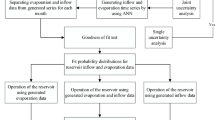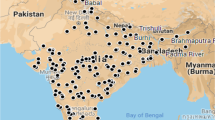Abstract
Inevitable evaporation and sedimentation will influence reservoir operational performance if the two fluxes have been ignored when sizing reservoir systems. While this is to be expected, very few studies have quantified this influence. This study has analysed the effects of evaporation and sedimentation on reservoirs operational performance. It used seven reservoirs in Yesilirmak Basin, Turkey as case studies. The Dams serve a variety of purposes including irrigation, domestic and industrial, hydropower generation and flood control. Performance with regard to meeting these needs was characterized using reliability (time-based and volume-based), resilience, vulnerability and sustainability. The results showed that while ignoring both the evaporation and sedimentation during planning does affect subsequent operational performance, the influence of evaporation was more significant. Possible reasons are provided for the outcome and ways by which both can be accommodated during planning analyses thus mitigating the operational effects are suggested.


Similar content being viewed by others
Data Availability
Some data, models or code used during the study are available from the corresponding author on request.
References
Adeloye AJ, Montaseri M, Garmann C (2001) Curing the misbehaviour of reservoir capacity statistics by controlling shortfall during failures using the modified sequent peak algorithm. Water Resour Res 37(1):73–82
Adeloye AJ, Nawaz NR, Montaseri M (1999) Climate change water resources planning impacts incorporating reservoir surface net evaporation fluxes: a case study. Water Resour Dev 15(4):561–581
Adeloye AJ, Soundharajan BS, Ojha CSP, Remesan R (2016) Effect of hedging-integrated rule curves on the performance of the Pong Reservoir (India) during scenario-neutral climate change perturbations. Water Resour Manage 30:445–470. https://doi.org/10.1007/s11269-015-1171-z
Araújo JCD, Güntner A, Bronstert A (2006) Loss of reservoir volume by sediment deposition and its impact on water availability in semiarid Brazil. Hydrol Sci J 51(1):157–170. https://doi.org/10.1623/hysj.51.1.157
Campos JNB (2010) Modeling the yield–evaporation–spill in the reservoir storage process: The regulation triangle diagram. Water Resour Manage 24:3487–3511. https://doi.org/10.1007/s11269-010-9616-x
Chaudhary HP, Isaac N, Tayade SB, Bhosekar VV (2019) Integrated 1D and 2D numerical model simulations for flushing of sediment from reservoirs. ISH Journal of Hydraulic Engineering 25(1):19–27
Conway D (1996) The impacts of climate variability and future climate change in the Nile Basin on water resources in Egypt. Int J Water Resour Develop 12:277–296
Espa P, Brignoli ML, Crosa G, Gentili G, Quadroni S (2016) Controlled sediment flushing at the Cancano Reservoir (Italian Alps): Management of the operation and downstream environmental impact. J Environ Manage 182:1–12
Gökbulak F, Özhan S (2006) Water loss through evaporation from water surfaces of lakes and reservoirs in Turkey. E-Water: Official Publication of the European Water Association (on line).http://www.ewaonline.de. ISSN 1994–8549
Gupta V, Tadros M, Bradshaw RW, Showalter SK, Miller JE, Evans L, Sasaki DY (2002) Progress Report: Advanced Concepts Group Fy01–1362-LDRD, Solutions to National and Global Security Issues Based on Limited Freshwater Resources, SAND2002–0781, Sandia National Laboratories, Albuquerque, NM
Hashimoto T, Stedinger JR, Loucks DP (1982) Reliability, resiliency, and vulnerability criteria for water resource system performance. Water Resour Res 18(1):14–20
Lowe LD, Webb JA, Nathan RJ, Etchells T, Malano HM (2009) Evaporation from water supply reservoirs: An assessment of uncertainty. J Hydrol 376:261–274
Mahmood K (1987) Reservoir sedimentation: Impact, extent, mitigation, World Bank Tech. Rep. 71, Washington, D. C
McMahon TA, Adeloye A (2005) Water Resources Yield. Water Resources Publications
McMahon TA, Finlayson BL, Haines AT, Srikanthan R (1992) Global runoff- continental comparisons of annual and peak discharges. (CATENA VERLAG, W-3302 CREMLINGEN-Destedt, Germany)
Montaseri M, Adeloye AJ (2004) A graphical rule for volumetric evaporation loss correction in reservoir capacity-yield performance planning in Urmia Region. Iran Water Resources Management 18:55–74
Moran PAP (1956) A probability theory of a dam with a continuous release, Q. J. Maths, 7
Oki T, Kanae S (2006) Global hydrological cycles and world water resources. Science 313:1068–1072
Recaa J, García-Manzanob A, Martíneza J (2015) Optimal pumping scheduling model considering reservoir evaporation. Agric Water Manag 148:250–257
Republic of Turkey Ministry of Agriculture and Forestry Geodata, geodata.ormansu.gov.tr (Data accessed: 08.06.2019)
Shokri A, Haddad OB, Mariño MA (2013) Reservoir operation for simultaneously meeting water demand and sediment flushing: Stochastic dynamic programming approach with two uncertainties. J Water Resour Plann Manage 139(3):277–289
Sivapragasam C, Vasudevan G, Maran J, Bose C, Kaza S, Ganesh N (2009) Modeling evaporation-seepage losses for reservoir water balance in semi-arid regions. Water Resour Manage 23:853–867. https://doi.org/10.1007/s11269-008-9303-3
Tadesse A, Dai W (2019) Prediction of sedimentation in reservoirs by combining catchment based model and stream based model with limited data. Int J Sedim Res 34:27–37
Tate EL, Farquharson FAK (2000) Simulating reservoir management under the threat of sedimentation: The case of Tarbela Dam on the River Indus. Water Resour Manage 14:191–208
Vörösmarty CJ, Green P, Salisbury J, Lammers RB (2000) Global water resources: vulnerability from climate change and population growth. Science 289:284–288. https://doi.org/10.1126/science.289.5477.284
Wang G, Wu B, Wang ZY (2005) Sedimentation problems and management strategies of Sanmenxia Reservoir, Yellow River. China Water Resources Research 41:W09417. https://doi.org/10.1029/2004WR003919
Wang Z, Hu C (2009) Strategies for managing reservoir sedimentation. Int J Sedim Res 24:369–384
White WR (2001) Evacuation of sediment from reservoirs. Thomas Telford, London
World Commission on Dams (2000) Dams and Development: A New Framework for Decision Making. Earthscan, London, UK
Wu B, Wang G, Xia J (2007) Case study: Delayed sedimentation response to inflow and operations at Sanmenxia Dam. J Hydraul Eng 133(5):482–494
Wurbs RA, Ayala RA (2014) Reservoir evaporation in Texas, USA. J Hydrol 510:1–9
Yin XA, Yang ZF, Petts GE, Kondolf GM (2014) A reservoir operating method for riverine ecosystem protection, reservoir sedimentation control and water supply. J Hydrol 512:379–387
You JY, Cai X (2008) Hedging rule for reservoir operations: 2. A Numerical Model, Water Resources Research 44:W01416. https://doi.org/10.1029/2006WR005482
Zhao G, Gao H, Cuo L (2016a) Effects of urbanization and climate change on peak flows over the San Antonio River Basin. Texas J Hydrometeorol 17:2371–2389. https://doi.org/10.1175/JHM-D-15-0216.1
Zhao G, Gao H, Naz BS, Kao SC, Voisin N (2016b) Integrating a reservoir regulation scheme into a spatially distributed hydrological model. Adv Water Resour 98:16–31
Acknowledgements
The authors are grateful to The Scientific and Technological Research Council of Turkey, Directorate of Science Fellowships and Grant Programmes (BİDEB), 2214-International Research Fellowship Programme for their funding support to Murat Pinarlik to undertake a period of attachment at Heriot-Watt University, UK, during which the work was undertaken. We also thank the Turkish Republic General Directorate of State Hydraulic Works for providing the data.
Funding
The research is an outcome of the overseas visiting doctoral fellowship awarded to Murat Pinarlik by The Scientific and Technological Research Council of Turkey, Directorate of Science Fellowships and Grant Programmes (BİDEB), 2214-International Research Fellowship Programme to undertake a period of attachment at Heriot-Watt University, UK.
Author information
Authors and Affiliations
Contributions
Murat Pinarlik: Conceptualisation, Software, Formal analysis, Writing- original draft, Scholarship awardee. Adebayo J. Adeloye: Supervision, Visualisation, Review of results, Writing- review and editing. Zeliha Selek: Supervision, Investigation, Writing- review and editing,
Corresponding author
Ethics declarations
Ethical Approval
The authors declare that the work reported is original and has not been submitted for publication elsewhere. All mention of third party works have been duly acknowledged and referenced.
Consent to Participate
All the authors agreed with the content of the article and all gave explicit consent to submit the work for publication.
Consent to Publish
All the authors obtained consent from the responsible authorities at their respective institutions thus paving the way for the work to be submitted.
Conflict of Interests
All authors certify that they have no affiliations with or involvement in any organization or entity with any financial interest or non-financial interest in the subject matter or materials discussed in this manuscript.
Additional information
Publisher's Note
Springer Nature remains neutral with regard to jurisdictional claims in published maps and institutional affiliations.
Highlights
• Evaporation and sediment exclusion affects reservoir size
• During reservoir operation, evaporation effect is more significant
• Both effects will increase with higher sediment yield and net evaporation
Appendices
Appendix A
Appendix B
Appendix C
Rights and permissions
About this article
Cite this article
Pinarlik, M., Adeloye, A.J. & Selek, Z. Impacts of Ignored Evaporation and Sedimentation Fluxes at Planning on Reservoir Performance in Operation. Water Resour Manage 35, 3539–3570 (2021). https://doi.org/10.1007/s11269-021-02904-5
Received:
Accepted:
Published:
Issue Date:
DOI: https://doi.org/10.1007/s11269-021-02904-5


















